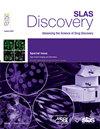Orthogonal temperature-related intensity change (TRIC) and TR-FRET as a high-throughput screening platform for the discovery of SLIT2 binders: A proof-of-concept approach
IF 2.7
4区 生物学
Q2 BIOCHEMICAL RESEARCH METHODS
引用次数: 0
Abstract
SLIT2, a secreted glycoprotein involved in axon guidance, immune modulation, and tumor progression, remains largely unexplored as a pharmacological target due to the absence of small-molecule modulators. Here, we present a proof-of-concept high-throughput screening platform that integrates Temperature-Related Intensity Change (TRIC) technology with time-resolved Förster resonance energy transfer (TR-FRET) to identify small molecules capable of disrupting the SLIT2/ROBO1 interaction. Screening a lipid metabolism–focused compound library (653 molecules) yielded bexarotene, as the most potent small molecule SLIT2 binder reported to date, with a dissociation constant (KD) of 2.62 µM. Follow-up TR-FRET assays demonstrated dose-dependent inhibition of SLIT2/ROBO1 interaction, with relative half-maximal inhibitory concentration (relative IC50) = 77.27 ± 17.32 µM, with a maximal inhibition (Imax) of ∼40 % at 400 µM. These findings suggest a novel extracellular activity of bexarotene and validate the combined use of TRIC and TR-FRET as a scalable screening strategy for SLIT2-targeted small molecules. This platform lays the groundwork for future high-throughput discovery efforts against SLIT2 and its signaling axis.

正交温度相关强度变化(TRIC)和TR-FRET作为发现SLIT2结合物的高通量筛选平台:概念验证方法
SLIT2是一种参与轴突引导、免疫调节和肿瘤进展的分泌糖蛋白,由于缺乏小分子调节剂,SLIT2作为药理学靶点在很大程度上尚未被探索。在这里,我们提出了一个概念验证的高通量筛选平台,该平台集成了温度相关强度变化(TRIC)技术和时间分辨Förster共振能量转移(TR-FRET),以识别能够破坏SLIT2/ROBO1相互作用的小分子。筛选以脂质代谢为重点的化合物文库(653个分子)得到bexarotene,作为迄今为止报道的最有效的SLIT2小分子粘合剂,其解离常数(KD)为2.62µM。后续的TR-FRET试验显示SLIT2/ROBO1相互作用的抑制呈剂量依赖性,相对半最大抑制浓度(相对IC50) = 77.27±17.32µM,在400µM时最大抑制(Imax)为~ 40%。这些发现表明贝沙罗汀具有一种新的细胞外活性,并验证了TRIC和TR-FRET联合使用作为slit2靶向小分子的可扩展筛选策略。该平台为未来针对SLIT2及其信号轴的高通量发现工作奠定了基础。
本文章由计算机程序翻译,如有差异,请以英文原文为准。
求助全文
约1分钟内获得全文
求助全文
来源期刊

SLAS Discovery
Chemistry-Analytical Chemistry
CiteScore
7.00
自引率
3.20%
发文量
58
审稿时长
39 days
期刊介绍:
Advancing Life Sciences R&D: SLAS Discovery reports how scientists develop and utilize novel technologies and/or approaches to provide and characterize chemical and biological tools to understand and treat human disease.
SLAS Discovery is a peer-reviewed journal that publishes scientific reports that enable and improve target validation, evaluate current drug discovery technologies, provide novel research tools, and incorporate research approaches that enhance depth of knowledge and drug discovery success.
SLAS Discovery emphasizes scientific and technical advances in target identification/validation (including chemical probes, RNA silencing, gene editing technologies); biomarker discovery; assay development; virtual, medium- or high-throughput screening (biochemical and biological, biophysical, phenotypic, toxicological, ADME); lead generation/optimization; chemical biology; and informatics (data analysis, image analysis, statistics, bio- and chemo-informatics). Review articles on target biology, new paradigms in drug discovery and advances in drug discovery technologies.
SLAS Discovery is of particular interest to those involved in analytical chemistry, applied microbiology, automation, biochemistry, bioengineering, biomedical optics, biotechnology, bioinformatics, cell biology, DNA science and technology, genetics, information technology, medicinal chemistry, molecular biology, natural products chemistry, organic chemistry, pharmacology, spectroscopy, and toxicology.
SLAS Discovery is a member of the Committee on Publication Ethics (COPE) and was published previously (1996-2016) as the Journal of Biomolecular Screening (JBS).
 求助内容:
求助内容: 应助结果提醒方式:
应助结果提醒方式:


